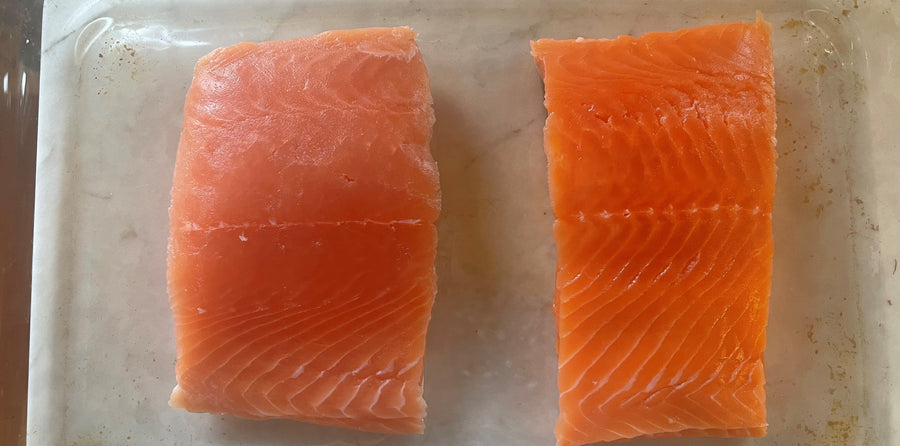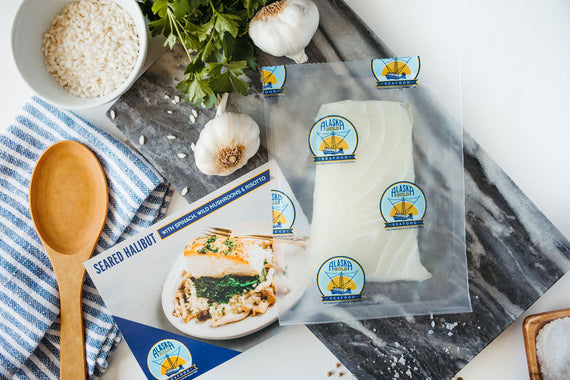
We get questions on how our coho salmon compares to our keta salmon. As it is for our king salmon, what makes all of our Alaska Gold wild salmon so special is that it is caught on hook and line. Each fish is handled one at a time. They are bled and gutted and then iced within minutes of catch by the fishermen in our fishermen-owned co-op who take great pride in producing the finest quality seafood.
Our king salmon is our most popular offering. A very close second in terms of our wild salmon is our coho salmon. For some of us, coho salmon is our favorite. And some of our customers believe that you get more bang for your buck with coho salmon than king salmon. Our keta salmon should not be dismissed though. Much more economical than king salmon and also less expensive than our coho salmon, too, keta salmon is very mild, versatile, and is probably the easiest salmon for people who don’t like salmon to enjoy.
Coho salmon and keta salmon are members of the Pacific salmon family and two of the five species of wild salmon caught in Alaska, where all finfish farming is illegal. Coho salmon (Oncorhynchus kisutch), otherwise known as silver salmon, are a platonic ideal for those who love fine salmon. Keta salmon (oncorhynchus keta) is also known as chum salmon or dog salmon. Mushers traditionally fed their sled dogs keta salmon, one possible source for their nickname. Also, keta salmon have large canine-like teeth when they return to freshwater to spawn, another reason for the dog salmon moniker. Keta salmon is firm in texture and is packed with lean, high-quality protein. It’s also the most widely distributed salmon in Alaska and the second largest salmon in pure size.
Other differences between coho salmon and keta salmon include the below:
Size: Coho salmon are typically smaller than keta salmon. We catch the bulk of our coho salmon and keta salmon from June through September. As the summer progresses, both of these species of salmon get dramatically bigger. Coho salmon start out in June around 4 to 5 pounds and then as the season goes on they can get up to 10 to 12 pounds and even bigger. Keta salmon start out more in the range of 6 to 8 pounds and can get up to even 18 to 20 pounds.
Color: Coho salmon have a bright orange-red meat color, while keta salmon have a lighter meat color with a slight browner hue and tighter grain. See picture below with the keta salmon portion on the left and a coho salmon portion on the right.

As they get closer to spawning, keta salmon's skin takes on an almost psychedelic red-green color and their teeth become more pronounced. Fishermen call them “gators” when their teeth grow out, as they start looking like alligators. Coho salmon take a darker color with a reddish hue as they get closer to spawning. Another benefit of our Alaska Gold salmon being caught on hook and line is that they are caught on the open ocean and their skin color will be silver bright. In addition, their meat won’t have the off flavor that salmon approaching freshwater streams to spawn will have.
Flavor: Coho salmon has a mild, slightly sweet flavor. It is a perfect salmon for fine dining. Coho salmon are highly prized for their culinary qualities and are commonly used for filleting and cooking. They are enjoyed in a variety of preparations, including grilling, poaching, baking, sautéing, and raw in sushi and sashimi.
Keta salmon has a very mild flavor, almost earthy, but in a good way. With its very mild flavor, keta salmon is almost like a chicken but with the sweet savory flavor of the sea. Since it is so mild, keta salmon is versatile to prepare with your favorite sauces. We offer this Keta salmon Curry with lemongrass and galanga recipe, for example. Keta salmon is also commonly smoked, but you can grill keta salmon or fry it on a skillet. Keta salmon is much less delicate in texture than coho salmon. Chef Jack Amon from Anchorage notes that a keta salmon cooks well in a hot skillet and its skin will crisp nicely; add juice from a lemon, capers, and a butter sauce and you will be pleased.
Here are some other considerations:
- Cost: Since they are caught in much greater numbers, keta salmon is typically less expensive than coho salmon. When ordered in bulk, our keta salmon is very economical.
- Nutrition: See below table for nutrition highlights for keta salmon and coho salmon.

Note that the vitamin B12 numbers are off the charts! This is typical for wild Alaskan seafood. Though coho salmon has more omega-3s per 3-ounce serving than keta salmon, they both have significant quantities of omega-3s, more than you’d find in just about any other food.
Another interesting note about keta salmon is that they are valued greatly for their roe. Keta salmon make the best salmon roe for making the sushi treat ikura because their eggs are very large and juicy and pop in your mouth for a fun experience. We sell our keta salmon roe to wholesalers who process it into ikura with a little salt and then is sold to sushi restaurants.
It's worth noting that these characteristics can vary to some extent depending on the specific habitat and geographical region where the fish are sourced. All of our wild salmon are caught in southeast Alaska near our processing plant in Sitka, Alaska. It is a wild region with limited population and industry. These fish are coming from pure, clean waters, and some of the most special fish on the planet. We can highly recommend both our wild coho salmon and our wild keta salmon.



